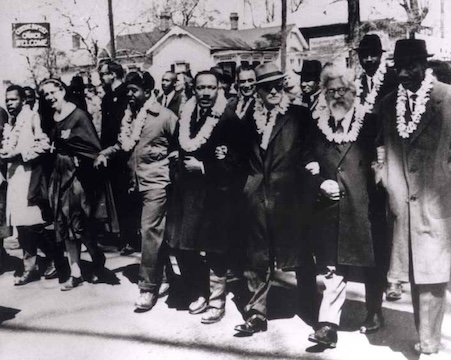Optimism is hard to come by these days. From the weather to Philly sports to politics and global affairs, there is so much to lament. I count myself lucky that winter is not usually a downer for me. As I looked for inspiration to hold onto the light of the holiday season or to the growing light of each day, I found myself thinking about how religious tradition works so hard to counter darkness.
This weekend brings to the forefront two religious figures whose counter-cultural stances offer a deep contrast to the cold realities of our world. Monday, we celebrate Rev. Dr. Martin Luther King Jr.’s birthday (both as his actual birthday and a national holiday); today, Sunday, we mark the yahrzeit (the anniversary of the death) of Rabbi Abraham Joshua Heschel.
To oversimplify grossly each of their contributions, King preached non-violence and love in a world full of hate and brutality; Heschel taught wonder and awe in a world of mechanization and suburban ennui. In their challenges to the world, as it seemed, they each drew deeply from their religious background to find meaning, purpose, and hope. Can it be a coincidence that we celebrate their legacy (and often that they marched in Selma together) at this time of year?
On the Jewish calendar, we are early in the Hebrew month of Shvat. When the moon is full, Jews will celebrate a Jewish Arbor Day, Tu B’Shvat, with plantings, ecological lessons and actions, and foods with kabbalistic meanings. Tu B’Shvat is a combination of an ancient tax day on orchard trees and a marking of the blossoming of almond trees as a sign of the coming spring.
Inherent in all these traditions is an eye for early growth, not cold, fallow ground. While we expect and do celebrate the harvest, there is something quite different about noticing buds. To make clear the optimism Jewish wisdom encourages specifically at this time, the rabbis say that Shvat is an acrostic for sh’tihiyu besorot tovot (that there should be good tidings).
In my house, I have a painting by the artist Morris Dahan that hangs above my fireplace. It has a golden tree, meant to represent the Tree of Life. All around it are leaves blowing in the wind. There is something a bit odd about those leaves, though; they are falling up. Something about how each leaf points draws the eye upward, not down. In looking up, the “fall” takes on an aspect of spiritual uplift. The Tree of Life becomes, for me, a symbol not of sin and loss but of hope and life.
What if the message of middle winter is not of icy isolation or hard conflict but is instead its polar opposite? What if the message is to see the prevailing culture and environment and to find signs of resilience, of change, of hope? We often make figures like King and Heschel into paragons of excellence; it takes the pressure off of us to live up to their example. Shvat, in the rabbinic imagination, does not ask us to be exemplars; Shvat asks us to be optimists.
This winter, let us look with awe and wonder, let us look for love and peace, and let our eyes be drawn upward to see what is embedded into the fabric of it all. The challenges and the chills, the hard parts and the rough patches, the losses and the learning– all of it contains possibility, a real and realistic source for seeing something else, a season for optimism. Now is the time.
About Rabbi Jeremy Winaker
Rabbi Jeremy Winaker is the executive director of the Greater Philadelphia Hillel Network, responsible for West Chester University, Haverford, Bryn Mawr, and other area colleges. He is the former head of school at the Albert Einstein Academy in Wilmington and was the senior Jewish educator at the Kristol Hillel Center at the University of Delaware for four years. Rabbi Winaker lives in Delaware with his wife and three children.



Comments